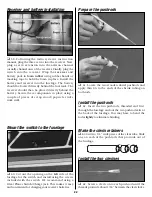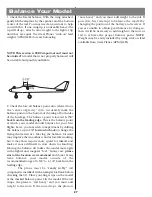
Horizontal Stabilizer
– The hor-
izontal tail surface at the back
of the
fuselage
which provides
aerodynamic pitch stability and
control to the airplane.
Low Wing
– An airplane with
the wing mounted on the bot-
tom of the
fuselage
.
Main Landing Gear
– The land-
ing gear and wheels which are
usually on the bottom of the
fuselage
under the wing on a
high wing airplane, or on the
bottom of the wing on a low
wing airplane.
Mid Wing
– An airplane with
the wing mounted in the center
of the
fuselage
, between the top
and bottom.
Muffler
– A device attached to
the exhaust stack of the engine
to reduce noise, and increase
back pressure which helps low
speed performance. Note: Most
R/C Clubs require the use of
mufflers.
Needle Valve
– Adjustment on a
carburetor
used to set proper
fuel mixture. Some carburetors
have separate needle adjust-
ments for low and high throttle.
Typically turning the needle
clockwise (screwing in) leans
the mixture and vice versa.
However, there are a few excep-
tions—refer to the engine man-
ufacturer’s instructions.
NiCd
– Nickel Cadmium bat-
tery. Rechargeable batteries
which are typically used as
power for radio control
trans-
mitters
and
receivers
.
Nitro
– NitroMethane, a fuel
additive which increases a
model airplanes’ ability to idle
low and improves high speed
performance. Ideal nitro con-
tent varies from engine to
engine. Refer to the engine
manufacturers’ instructions for
best results. Nitro content in
fuel is indicated by the percent
of the fuel.
Nose Gear
– The landing gear at
the nose of the airplane if the
airplane is a Tricycle landing
gear type. Typically connected
to the
rudder servo
for ground
steering.
Pattern Airplane
– A model air-
plane designed to perform pre-
cision aerobatics.
Pitch Axis
– The airplane axis
controlled by the
elevator.
Pitch
is illustrated by holding the air-
plane at each wingtip. Raising
or lowering the nose is the pitch
movement. This is how the
climb or dive is controlled.
Pushrod-A rigid piece of wood,
fiberglass, nylon or steel used to
transfer movement from a
servo to a control surface or
throttle.
Pylon Racing Airplane
– A
model airplane designed for
racing. They are flown around a
set course of (3) "Pylons."
Receiver (Rx)
– The radio unit
in the airplane which receives
the
transmitter
signal and
relays the control to the
servos.
This is somewhat similar to the
radio you may have in your
family automobile, except the
radio in the airplane perceives
commands from the transmit-
ter and the radio in your car
perceives music from the radio
station.
Roll Axis
– The airplane axis
controlled by the
ailerons.
Roll
is illustrated by holding the air-
plane by the nose and tail.
Dropping either wingtip is the
roll movement. This is used to
bank or turn the airplane.
Rudder
– Hinged control surface
located at the trailing edge of the
vertical stabilizer, which pro-
vides control of the airplane
about the
Yaw axis
and causes
the airplane to Yaw left or right.
Left rudder movement causes
the airplane to Yaw left and right
rudder movement causes it to
Yaw right.
Sailplane
– An airplane which
flies without an engine.
Sailplanes are designed to ride
on warm, rising air currents,
called thermals. Sailplanes are
launched by several methods; a
giant sling shot called a high
start, a winch which pulls the
sailplane up like a kite, or with
the assistance of a small engine
or electric motor.
Servo
– The electronic/
mechanical device which
moves the control surfaces or
throttle of the airplane accord-
ing to commands from the
receiver. The radio device
which does the physical work
inside the airplane.
Servo Output Arm
– The remov-
able arm or wheel which bolts to
the output shaft of a servo and
33
Words shown in italics are defined elsewhere in this glossary.


















